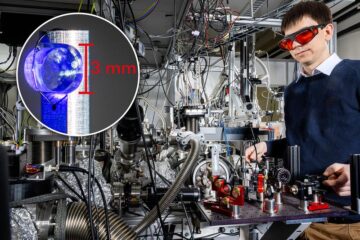Laboratory scientists study soot in megacity pollution

A team of Los Alamos scientists recently returned from a month-long data-gathering trip to Mexico City as part of an international, multi-agency environmental science collaboration. The March campaign was designed to examine the chemical and physical transformations of gases and aerosols in the polluted outflow from the Mexico City metropolitan area. With a population of 25 million, Mexico City is North America’s largest city, what scientists are calling a megacity. As such, it provides an excellent testing ground for understanding the regional and global impacts of increasing urbanization.
The Los Alamos team was led by Manvendra Dubey and included Claudio Mazzoleni and Thom Rahn. Together, they performed measurements of the radiative and optical properties of soot using a state-of-the-art Los Alamos-developed field-deployable photo-acoustic instrument. The Los Alamos team also provided the only measurements of molecular hydrogen in Mexico City. The Los Alamos measurements were designed to provide a unique data set for quantifying Mexico City’s atmospheric soot, which is little more than fine carbon particles.
Soot is produced by diesel combustion, burning of biomass and power plants. Soot-containing aerosols absorb solar radiation, which causes atmospheric warming. However, soot’s warming potential is determined by complex interactions with other anthropogenic aerosols, such as sulfate and organics, which by scattering solar radiation tend to offset the warming caused by pure soot.
The data are already beginning to tell the story of Mexico City’s environment. A very regular daily profile has emerged revealing peak concentrations of both hydrogen and soot in early morning caused by the high traffic volume and pollution close to the ground. The instrumentation recorded levels of hydrogen at 5 parts per million, which is 10 times more than normal background levels. Scientists theorize that most of the hydrogen is coming from automobiles.
One of the key objectives of the Los Alamos team now is to integrate the net radiative effects of all pollutants: carbon dioxide, aerosols and ozone, and changes in the amount of light that reaches the ground that are observed in Mexico City could help determine the global warming potential of a megacity.
Media Contact
All latest news from the category: Ecology, The Environment and Conservation
This complex theme deals primarily with interactions between organisms and the environmental factors that impact them, but to a greater extent between individual inanimate environmental factors.
innovations-report offers informative reports and articles on topics such as climate protection, landscape conservation, ecological systems, wildlife and nature parks and ecosystem efficiency and balance.
Newest articles

Biomarkers identified for successful treatment of bone marrow tumours
CAR T cell therapy has proven effective in treating various haematological cancers. However, not all patients respond equally well to treatment. In a recent clinical study, researchers from the University…

She deciphers how tomato roots communicate
Ora Hazak has always been fascinated by plants and is studying the signals that roots send to the rest of the organism. She aims to understand this communication in order…

Laser excitation of a nucleus
A long-awaited breakthrough opens the door to a new type of atomic clock and the investigation of fundamental questions in physics. After decades of investigation, researchers made an extraordinary quantum…





















